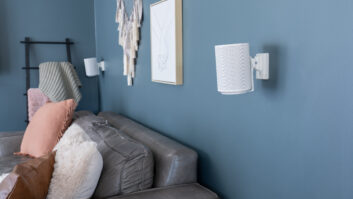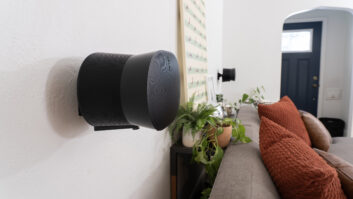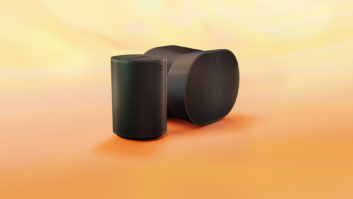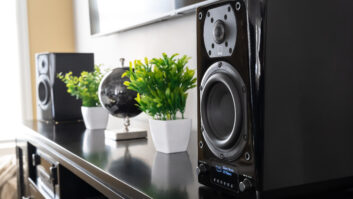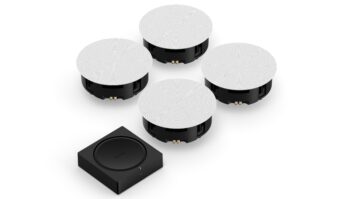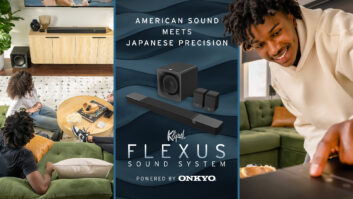Kudos: Era 100 offers big step up for small price increase; Era 300 adds exciting spatial audio playback and height element to Sonos surround systems; spatial audio experience a massive improvement over stereo
Concerns: Finding Atmos tracks within Sonos app; grouping with non-Atmos capable speakers
While Sonos’ recent product launches have focused around portable speakers (Move and Roam) and home theater components (Arc, Beam (Gen 2), Ray, and Sub Mini), the company has finally turned its attention back to its line of standalone speakers with the introduction of the new Era Series, which consists of the 100 and 300. (Please know that I resisted the temptation to use a “Sonos ushers in a new era of speakers” pun. You’re welcome.)
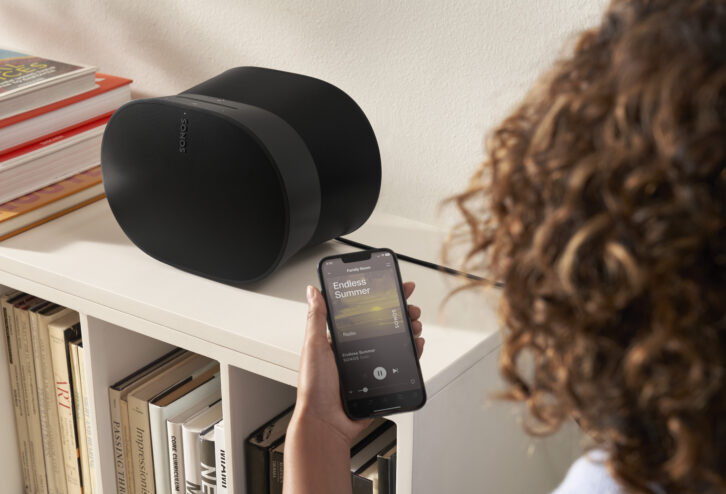
First off, I’m thrilled we have a new name/series here, and not some other permutation of Play:1, One, One [Gen 2], and One SL to further confuse clients and inventory systems. And beyond just a “We have some new speakers!” announcement, the two new Era models carve out clear performance niches in Sonos’ line.
While the Era 100 will appeal to listeners looking for a performance step up from the current One — specifically in single-speaker applications — the Era 300 is an entirely new beast, and is the first non-bar offered by Sonos specifically crafted to play back “spatial audio,” an immersive audio format designed to have a more 3D quality to the sound, adding more depth and height to the listening experience.
For this review, Sonos sent both an Era 100 and 300. To accompany the speakers, Sanus sent its new line of Era-compatible stands and mounts for both models.
What’s New
You’d be forgiven for thinking of the Era 100 as an upfit for the One series; Sonos refers to it as “a remastering of the best-selling Sonos One,” however it distinguishes itself visually by being a little taller and far rounder/more circular. Sitting next to a One, the 100 looks more elegant, less boxy, and, dare I say, less cheap?
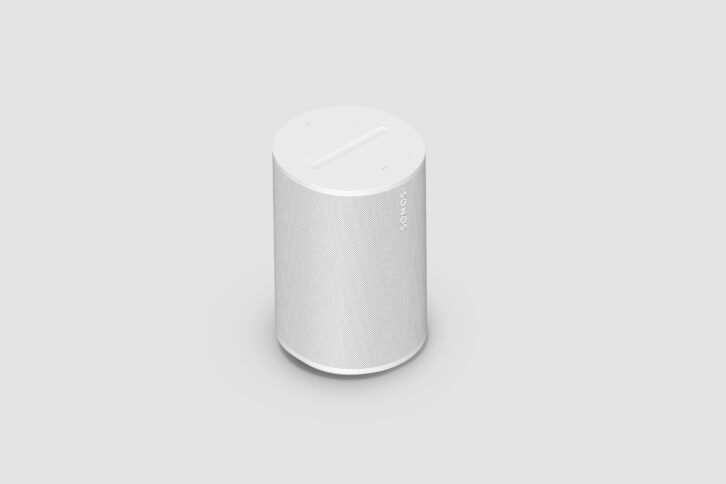
Sonically, the 100’s big improvements come in the form of a new woofer that is 25 percent larger, producing fuller, richer bass, and dual-angled tweeters with custom waveguides designed to expand the spaciousness and sense of stereo audio. As a single-speaker solution, this is a big step over the Ones.
While the 300 retains Sonos’ industrial design elements, it looks like nothing else in the lineup, with its oval shape, rounded front and sides, and flared rear. Sitting next to a Five, the 300 looks smaller, though it is a bit deeper. Honestly, it is a bit odd-looking at first, and I wasn’t even exactly sure how to orient it when first removing it from the box, thinking the back of the speaker was the bottom.
Setting it down, I thought, “Man, that’s dumb, they put the power connection on the bottom.” Fortunately, a rubber footing on the actual bottom is there as a kind of, “This end down, dummy!” (Also, the front-panel status light blinks orange/white if you don’t have the speaker oriented correctly.)
But talking about the 300’s shape is really burying the lede; its big trick is playing spatial audio, and it has been designed from the ground up with this in mind. Concealed behind its rounded, perforated grilles are a total of six drivers (four tweeters positioned in a front, left/right side, and up-firing array, along with two side-firing woofers) that are designed to immerse you in audio. Sonos doesn’t offer any details on the driver sizes or amplification in the 300, but says the speakers are powered by six Class-D amplifiers “precision tuned for the speaker’s unique acoustic architecture.”
While “spatial audio” is a generic term and not a specific audio format, with Sonos this refers to Dolby Atmos, as the company doesn’t support decoding for either DTS:X or Auro-3D. (Atmos is the overwhelming leader in spatial audio; Sony offers its competing 360 Reality Audio format via both Amazon and Tidal, which is another version of spatial audio, which is not currently supported by Sonos.)
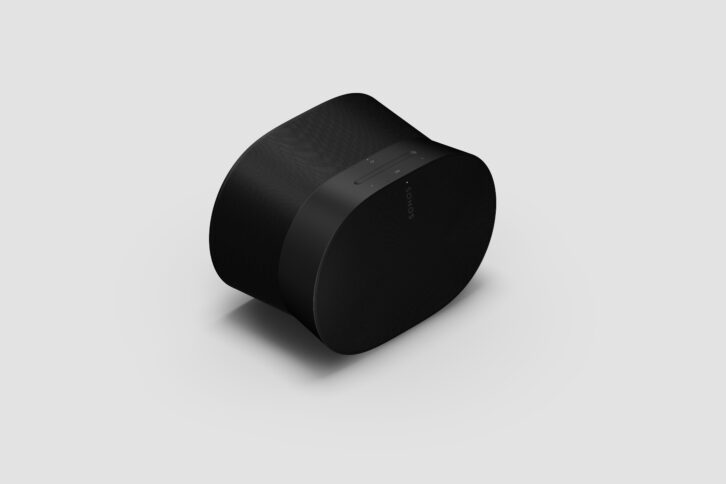
Currently, Sonos supports spatial audio streaming from Amazon and Apple Music. (I inquired about support for Tidal, and the company answered, “Over time we will continue to add more listening choices and partners.”) Spatial tracks must be selected within the Sonos app, meaning you won’t experience Atmos if trying to AirPlay or Bluetooth them to the speaker.
Both Era speakers feature a few things in common that are new to Sonos’ standalone units. First, like the portable speakers, they now support Bluetooth 5.0, and when Bluetooth-ing to one of the speakers, you can “group” in other Sonos speakers to listen.
Second, in addition to the “soft” microphone on/off button, there is now a physical connection to disable the internal microphone if you want to ensure that Big Brother is never listening. (A small white LED is illuminated on the top of the speaker when the mic is enabled.)
Third, the top-panel controls have been redesigned. I never used these capacitive touch buttons before because I always seemed to end up skipping tracks or messing up the volume, but the new layout is far more intuitive and actually usable.
Fourth, there are no longer physical connections for mini-jack line input or Ethernet; rather Sonos now offers an optional USB-C adapter for these connections.
Finally, on the voice control front, the Era speakers no longer support Google Assistant, now solely relying on Amazon Alexa and Sonos Voice. (According to Sonos, “Google has changed the technical requirements for Google Assistant on third-party devices. We’re evaluating these requirements, but it’s a heavy engineering lift and we’ll continue to prioritize work that builds on our vision of voice assistants all working concurrently. We remain hopeful that Google Assistant will be part of this ecosystem one day, but that’s really up to Google.”)
While not germane to performance, Sonos is also proud that both Era speakers are “made with post-consumer recycled plastic and packaged in 100 percent sustainably sourced paper,” plus they consume under 2 watts idle power. So, feel free to enjoy music without any guilt for the planet!
Both models are offered in matte black and white finishes, and I received one of each. One thing I noticed was that the black is really prone to showing smudges and fingerprints, something I never really noticed with previous Sonos products.
Setup
Like every new Sonos product, setup requires using the Sonos S2 “gold” app and connecting the device to a local network either via Wi-Fi (compatible with Wi-Fi 6, 2.4/5 GHz) or via Ethernet using the optional USB-C dongle. If you’ve ever set up a Sonos component, there are no surprises here, and I’m happy to say that Sonos isn’t requiring the (stupid!) eight-digit PIN code for either of these.
Out of the box, both Era 100 and 300 products prompted for a firmware update to software version 15.3. After performing this, they were ready to go.
Both speakers support Sonos’ Trueplay room tuning to measure in-room acoustics and make adjustments for best sound; however, there are now two flavors. There is a Quick Tuning option that uses the speaker’s internal microphones to listen and measure to a series of test tones, meaning that Android users will now be able to benefit. And there is the traditional Advanced method that requires walking around the room using the microphone in an iOS device.
Like all recent Sonos voice-capable products, the Era speakers support Sonos Voice Control. Using this requires you to “opt in” on each speaker, and then it performs another short update to enable this feature. Sonos touts “unmatched privacy” with its voice service, claiming, “Voice requests are processed on your product and never recorded, saved, or sent to the cloud.”
Sonos Voice commands, initiated by saying, “Hey, Sonos,” are considerably more limited than, say, Alexa — you can’t ask it about the weather, to turn any of your smart devices on/off, or really anything that doesn’t pertain to music playback — but it does let you do things like group and ungroup speakers, set precise volume levels, quickly and easily get music playing, and request specific music from Sonos Radio, Apple Music, Amazon Music, Deezer, and Pandora.
The LED lights are far more discreet on the Era speakers, with a small status light on the front of the speaker that illuminates in different colors to indicate a problem, if the speaker is “listening,” if the speaker is muted, or when in Bluetooth pairing mode.
The Era 300 also offers a couple of new listening settings in the setup app pertaining to spatial audio. For one, there is a height audio volume adjustment from –10/+10 dB, and there is a “Spatial Music” radial that disables the Atmos music playback. Why you would buy a speaker specifically for its ability to play spatial audio and then disable that feature is beyond me, but you can.
Both speakers enable pairing — as in two 100s, or two 300s — for stereo listening, and can be paired with a Sonos Gen 3 or Mini subwoofer. Both can be used in like pairs with either a Sonos Arc, Beam (Gen 2), or Ray soundbar as surround speakers. (Note that the Ray doesn’t support Dolby Atmos playback.)
While Sonos offers floor stands and wall mounts for both Era models, I reached out to Sanus for samples of its new Era-specific stands and mounts. Smartly, these can now be purchased as either singles or pairs.
I found the stands simple to assemble — roughly a 10-minute process — and with a sturdy enough footprint where I didn’t worry about them toppling. The fixed stands hold the speakers at 32/34 inches (300/100) off the floor, though Sanus also offers adjustable mounts that can position the speakers from 25 to 42 inches, ensuring an optimal height. The wall mounts are also straightforward, with the Era 300 mount allowing you to mount the speaker “upside down” if it is placed closer to the ceiling, letting its upfiring driver fire down to the listening area. Smart! Of course, you’ll still have to deal with the speaker’s power cord…
Performance
I’m not going to spend a ton of time on the Era 100. Not only does the 100 look better than the One, it also sounds better. The larger bass driver produces fuller, deeper bass, and the stereo tweeter array delivers a wider, more expansive soundstage. Also, the side-firing tweeters definitely do a better job of creating a room-filling sound, letting you hear more high-frequency details as you move off-center and around the room. It is definitely worth a $30 upgrade over a Sonos One.
The real story here is the Era 300, and that’s where I’m going to focus the bulk of my listening notes. Before I get to the good, I’m going to start with the bad.
Obviously, its big “trick” is its ability to play back Dolby Atmos-encoded titles, but that’s also the first hiccup in the chain. In order to enjoy this content, it has to be streamed from the Sonos app, but unfortunately there is currently no way to tell if you are selecting something that features Dolby Atmos inside the Sonos app until you start playing it. Now, once you start playing something, there is a Dolby Atmos logo in the Sonos “Now Playing” screen.
My solution was to browse music inside the Amazon Music app — which does indicate if an album is Atmos — then add it to my Amazon library, wait for that selection to appear in my Sonos library, and then play it in the Sonos app, which is a less-than-ideal way to do it. However, Sonos understands software, and I would assume this will be addressed in a future update.
The next little bugaboo is that, if you are listening to something in Atmos and you group in another speaker that isn’t Atmos-capable — say the Era 100 — then the Atmos decoding turns off on the 300. With a company that is so into whole-house listening, this is another bummer. Once you ungroup the speakers, the 300 will return to Atmos decoding if you restart the song currently playing or when the next song starts.
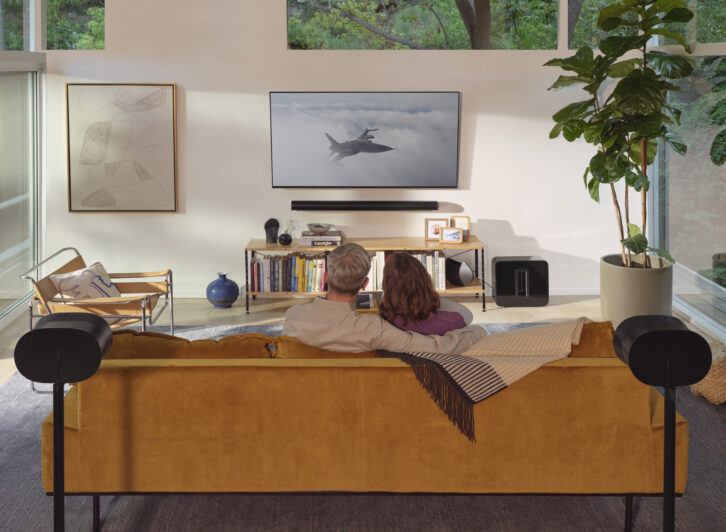
When playing back non-spatial-encoded content, the upfiring driver is unused. It would be nice if there was a way to enable it, like an “all-channel stereo” mode to get some more dimension or center fill to the music if desired, but there isn’t. (According to Sonos, “Even when playing stereo tracks, all of the speaker’s drivers are actively delivering sound sideways and forward. The upfiring driver is leveraged to deliver an added sense of spaciousness. All of this creates an immersive listening experience that can be enjoyed from anywhere in the room.” However, I did not find this to be the case. When playing back non-Atmos content, even with the height volume at +10 and my ear resting on top of the speaker, I was unable to hear anything coming from it.)
Also, when used as a surround speaker, the 300’s front tweeter is disabled. Sonos claims internal testing concluded it sounds better with this driver off, but I think giving users the ability to toggle this on/off in the surround settings would be a better option, similar to the Tripole array M&K used to offer. (To be fair, I wasn’t able to test it as a surround speaker since Sonos only sent me a single Era 300, but there is a fair bit of chatter about this on Reddit, as well as on the Sonos support boards, and two other reviewers confirmed this was the case.)
Now, the good — which is actually more aptly described as the great.
Once you’re over these hurdles, listening to Atmos-encoded audio from the Era 300 is just terrific, and switching to/from an Atmos mix can be startling, with width, expansiveness, and a sense of depth that just explode into the room.
Now, “height” isn’t in the sense of what you might typically expect from Atmos height channels, i.e., sounds coming above you or from overhead. I never heard “height” in this manner. I think a better description would be “spaciousness,” as the height speaker adds more dimension and helps raise the soundstage of the presentation above the physical speaker. I also felt the speaker sounded its best with nothing on either side of it and a wall behind it, as that helped to reinforce the height experience.
Some of the most fun is re-experiencing old songs in a new Atmos mix, as you’ll almost always notice something new. In a Sound & Vision interview with Giles Martin (son of original Beatles producer George Martin), he talks about using artificial intelligence to “de-mix” The Beatles album Revolver in Atmos. “I can now de-mix the drums and have the kick drum and the snare drum separately. Essentially, it’s like taking something that’s already been baked-in together, and then separating out the original ingredients.” Because the mixing has pulled out some sound element or repositioned it in the more expansive mix, you’ll notice fine details that were buried.
For example, the voices speaking during the opening of “Speak to Me” on the Pink Floyd Dark Side of the Moon Atmos remix float above the speaker in far more clarity, as do the other sounds that are lost in the noise of the stereo mix — like the individual clicking and clock sounds. Same for the NASA announcements in “Countdown” on Rush’s Signals. And the bird chirping in the background of Taylor Swift’s “Exile” is noticeably positioned high-right as opposed to just in the background.
When playing Atmos-encoded content, the soundstage is definitely far bigger and produces audio that expands far beyond the physical boundary of the speaker. Processed pop music like Coldplay, Billie Eilish, or Lorde certainly benefit from this expansiveness, but so do more stripped-down recordings like Norah Jones or even Frank Sinatra’s “Fly Me to the Moon,” which has an expansive and explosive brass section.
While the Era 300 is no slouch on non-spatial audio, it lags behind the performance of the Five, and if critical stereo listening is your goal, the Five is the better choice.
Comparing the two speakers side-by-side, the Five is clearly more detailed with forward-focused sound. This is especially noticeable with things like cymbals and other high frequencies that have far more sparkle and clarity than the Five, which just sounds livelier and more dynamic at both ends of the spectrum, producing noticeably deeper bass and delivering richer vocals.
With both speakers directly in front of me, the Era’s offset drivers deliver more width, giving instrumentation a bit more space and definition compared to the Five. Sonically, if the Five is a straight-ahead, precise bullet, the Era is a spherically expanding audio grenade.
However, when it comes to Atmos content on the Era 300 versus stereo content on the Five, the Era 300 trounces it. Hands down. Every time.
For customers subscribing to Amazon or Apple Music, the growing library of Atmos-encoded audio makes a compelling argument for the Era 300, and I daresay giving a demo will leave people impressed. Beyond its music capabilities, the Era 300 will likely be the go-to surround speaker in Sonos home theater setups for its ability to add true surround height channel capability to the system, allowing for a more immersive Sonos movie-watching experience.
800-680-2345; Sonos.com
Product Specs:
- Designed to deliver the best experience for spatial audio listening
- Includes six drivers (four tweeters, two woofers) that direct sound left, right, forward, and upward for immersive audio powered by six class-D amplifiers
- New, intuitive user interface with capacitive volume slider, play/pause, and track skip forward/reverse
- Wi-Fi 6, 2.4/5 GHz, Apple Airplay 2, Bluetooth 5.0; hardwired network connection via optional USB-C accessory
- Far-field microphone array for use with Amazon Alexa or Sonos Voice (defeatable via soft button or physical microphone switch)
- Requires Sonos S2 app for setup
- Can paired with Arc or Beam (Gen 2) to deliver Dolby Atmos theater surround
- Available in matte white or black finish
Dimensions:
- Era 300
- 3 x 10.24 x 7.28 inches (HxWxD)
- Weight: 9.75 pounds
- Era 100
- 18 x 4.12 x 5.14 inches (HxWxD)
- Weight: 4.44 pounds
